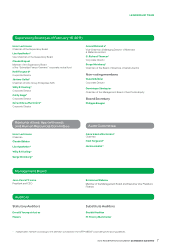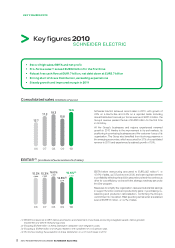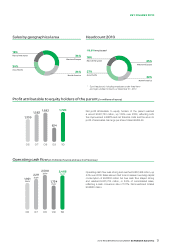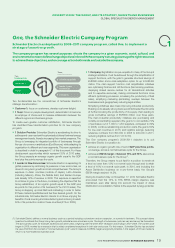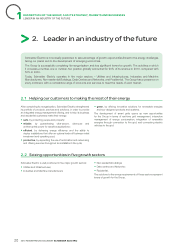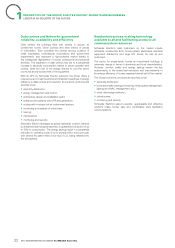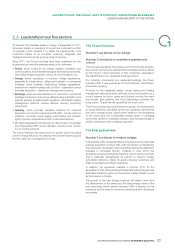APC 2010 Annual Report Download - page 19
Download and view the complete annual report
Please find page 19 of the 2010 APC annual report below. You can navigate through the pages in the report by either clicking on the pages listed below, or by using the keyword search tool below to find specific information within the annual report.
DESCRIPTION OFTHEGROUP, ANDITSSTRATEGY, MARKETS ANDBUSINESSES
1
GLOBAL SPECIALIST IN ENERGY MANAGEMENT
The world’s center of gravity is shifting, as are the opportunities for
growth.
Emerging economies are challenging mature countries for economic
supremacy, for example China, which became the world’s second
biggest economy in 2010.
With globalisation of economies and trade, people have completely
changed the way they do business, think of economic growth and
collaborate with stakeholders over the last two decades. It is no
longer simply a case of exporting technology; innovation is required
to meet the needs of each market. Schneider Electric’s presence in
more than 100 countries as well as its new organisation represent
decisive strengths for meeting these new challenges.
1. 3 The emergence of new economies
1. 4 A Group focused ongrowth
From steel to electricity, and then to energy management: the Group
has gone through many changes since it was founded 175years
ago in order to position itself in the most important growth markets.
1836 – 1980: From family business to world
leader
1836: Adolphe and Joseph-Eugène Schneider acquired steel
foundries in Le Creusot, France. They founded Schneider & Cie in
1838. The Company steadily built a presence in heavy mechanical
engineering and transportation equipment, gradually becoming a
huge, highly diversifi ed conglomerate.
1975: Merlin Gerin, a leading French manufacturer of electrical
distribution equipment, joined the Group in 1975, strengthening a
position in electricity that had been established at the end of the
19th century.
1981 – 2001: The Group refocuses on electricity
1988: Acquisition of France’s Telemecanique, a pioneer in remote
control systems for electric motors.
1991: Major acquisition of the US electrical equipment sector leader
Square D (sales of USD1.65billion).
1997: Sale of building and public works company Spie Batignolles.
The Group’s refocusing on the electricity sector is now complete.
1999: The name Schneider Electric represents the Group’s new
direction and provides a clear indication of its expertise in the
electricity sector.
•Acquisition of Lexel, Europe’s second largest supplier of
installation systems and control solutions.
2000: Acquisition of Crouzet Automatismes, a French leader in
electronic control, small automation devices and customised
sensors, and Positec, a European leader in motion control.
•Establishment of 60-40 joint venture with Toshiba called
Schneider Toshiba Inverters (STI) to develop, manufacture and
market both partners’ industrial speed drives. STI leads the
global industrial speed drive sector.
•Launch of Schneider Electric Ventures fund with capital of
EUR50million, to acquire interests in innovative start-ups with
technologies that can enhance the line up.
2001: Acquisition of Legrand, a leader in installation systems and
control solutions. The European Commission then vetoed the
merger, obliging Schneider Electric to sell its stake in Legrand, even
though the Court of First Instance of the European Communities
overruled the Commission’s decision in October2002.
2002-2009: Strategic transformation
Around the beginning of the new millennium, Schneider Electric
completely rethought its growth strategy, setting itself three goals:
•diversifying its exposure to end markets;
•enhancing its portfolio of traditional activities (electricity
distribution, automation and industrial control);
•anticipating the future energy requirements of fi rms and homes.
New dimension
The Group doubled in size between 2002 and 2008, through
organic growth and by making a number of acquisitions. Revenue
jumped from EUR9 billion in 2002 to EUR18.3 billion in 2008,
refl ecting average annual growth of 12%. Its headcount increased
from 70,000 to 114,000 over the same period. Thanks to a loosely
integrated business model, the Group can act quickly to keep pace
with economic and environment-related changes.
2003: Following several acquisitions, notably of TAC, Schneider
Electric became a major player in building automation.
2007: The Group became global leader in critical power and video
security systems, with the acquisition of APC and Pelco respectively.
2009: The acquisitions of energy effi ciency leader Conzerv in India
and UPS manufacturer Microsol Tecnologia in Brazil increased the
Group’s exposure to new economies, as well as to the growing
energy effi ciency and critical power sectors.
Change management
2001-2008: Launch of change management program NEW2004,
followed by NEW2 in 2005, with the aim of formalising consistent
and coordinated objectives for all employees.
2010 REGISTRATION DOCUMENT SCHNEIDER ELECTRIC 17


